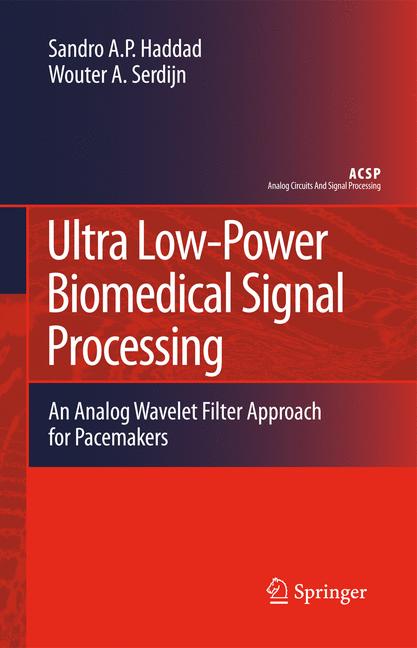(To see other currencies, click on price)
MORE ABOUT THIS BOOK
Main description:
Often WT systems employ the discrete wavelet transform, implemented on a digital signal processor. However, in ultra low-power applications such as biomedical implantable devices, it is not suitable to implement the WT by means of digital circuitry due to the relatively high power consumption associated with the required A/D converter. Low-power analog realization of the wavelet transform enables its application in vivo, e.g. in pacemakers, where the wavelet transform provides a means to extremely reliable cardiac signal detection.
In Ultra Low-Power Biomedical Signal Processing we present a novel method for implementing signal processing based on WT in an analog way. The methodology presented focuses on the development of ultra low-power analog integrated circuits that implement the required signal processing, taking into account the limitations imposed by an implantable device.
Contents:
1 Introduction. 1.1 Biomedical signal processing. 1.2 Biomedical applications of the wavelet transform. 1.3 Analog versus digital circuitry - a power consumption challenge for biomedical front-ends. 1.4 Objective and scope of this thesis. 1.5 Outline. 2 The Evolution of Pacemakers: An Electronics Perspective. 2.1 The Heart. 2.2 Cardiac Signals. 2.3 The history and development of cardiac pacing. 2.4 New Features in Modern Pacemakers. 2.5 Summary and Conclusions. 3 Wavelet versus Fourier analysis. 3.1 Introduction. 3.2 Fourier transform. 3.3 Windowing function. 3.4 Wavelet transform. 3.5 Signal Processing with Wavelet Transform. 3.6 Low-power analog wavelet filter design. 3.7 Conclusions. 4 Analog Wavelet filters: the need for approximation. 4.1 Introduction. 4.2 Complex First Order filters. 4.3 Pade Approximation in the Laplace domain. 4.4 L2 Approximation. 4.5 Other approaches for Wavelet bases approximation. 4.6 Discussion. 4.7 Conclusions. 5 Optimal State Space Descriptions. 5.1 State space description. 5.2 Dynamic Range. 5.3 Sparsity. 5.4 Sensitivity. 5.5 Conclusion. 6 Ultra Low-power Integrator Designs. 6.1 Gm-C filters. 6.2 Translinear (Log-domain) filters. 6.3 Class-A log-domain filter design examples. 6.4 Low-power Class-AB Sinh Integrators. 6.5 Discussion. 6.6 Conclusions. 7 Ultra Low-power Biomedical System Designs. 7.1 Dynamic Translinear Cardiac Sense Amplifier for Pacemakers. 7.2 QRS-complex wavelet detection using CFOS. 7.3 Wavelet filter designs. 7.4 Morlet Wavelet Filter. 7.5 Conclusions. 8 Conclusions and Future Research. 8.1 Future Research. A High-Performance Analog Delays. A.1 Bessel-Thomson approximation. A.2 Pade approximation. A.3 Comparison of Bessel-Thomson and Pade approximation delay filters. A.4 Gaussian Time-domain impulse-response method. B Model reduction - the BalancedTruncation method. C Switched-Capacitor Wavelet Filters. D Ultra-Wideband Circuit Designs. D.1 Impulse Generator for Pulse Position Modulator. D.2 A Delay Filter for an UWB Front-End. D.3 A FCC Compliant Pulse Generator for UWB Communications. Summary.
PRODUCT DETAILS
Publisher: Springer
Publication date: October, 2010
Pages: 218
Weight: 454g
Availability: Available
Subcategories: Biomedical Engineering
Publisher recommends
From the same series











